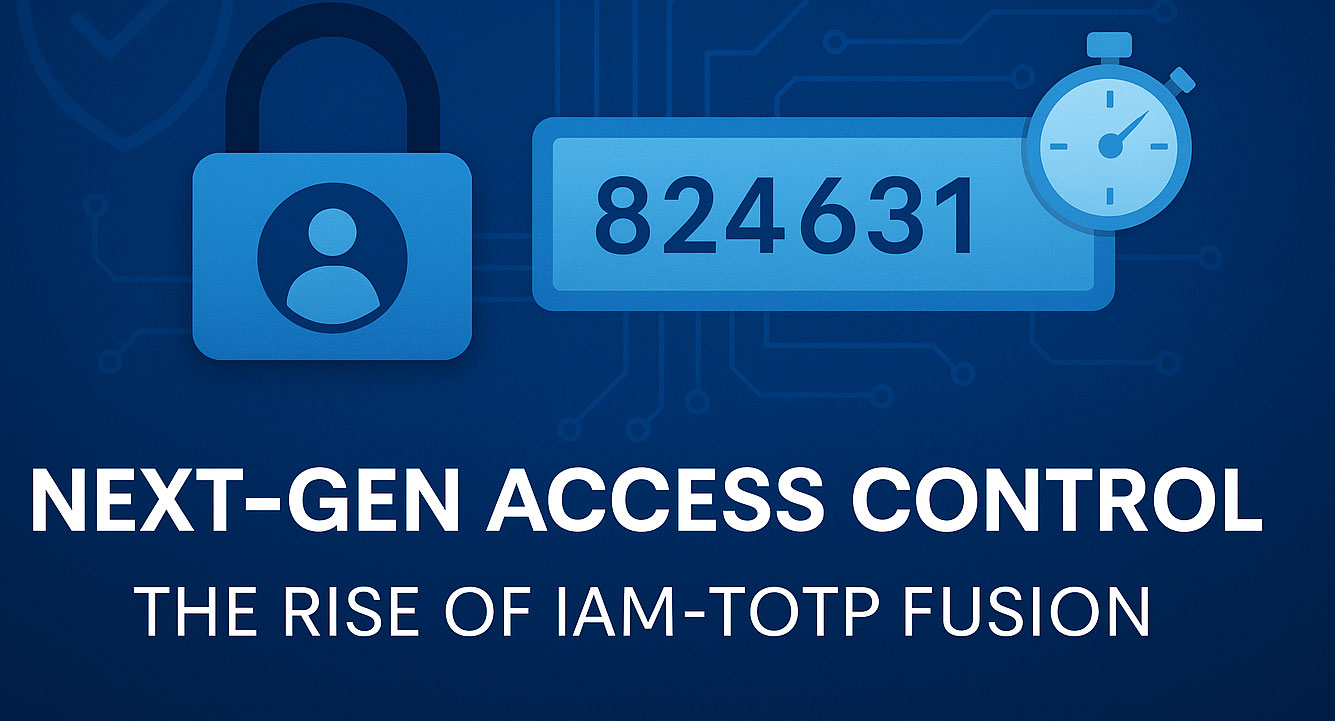No products in the cart.
 Reinventing Trust in the Digital Era
Reinventing Trust in the Digital Era
As cloud applications, hybrid workforces, and cyber threats reshape modern IT, digital trust becomes foundational—not optional. However, organizations must earn and enforce that trust—not assume it. This is precisely where Identity and Access Management (IAM) and Time-Based One-Time Passwords (TOTP) come into play, forming the backbone of modern access control.
IAM governs digital identities by defining who receives access, when, and under what conditions. At the same time, TOTP strengthens that access using dynamic, time-sensitive codes that are difficult to intercept or reuse. Together, they establish a multi-layered access control system that effectively balances security with usability.
Understanding IAM: The Access Gatekeeper
IAM serves as the strategic framework that manages user identities across systems. To ensure consistent protection, it enforces rigorous validation, approval, and tracking of each access request—upholding critical security and governance standards. Specifically, the four key functions of IAM include:
- Identity verification – Verifies that the user is authorized and genuine before granting access.
- Authorization – Grants or restricts access based on role or policy
- Policy enforcement – Applies access rules dynamically across systems
- Auditing – Tracks and logs activity for compliance and threat response
Without a structured IAM framework, businesses risk privilege accumulation, unmanaged user accounts, and potential security breaches. With it, access becomes intentional, secure, and manageable.
TOTP: A Dynamic Defense Layer
Time-Based One-Time Passwords are a simple yet powerful second factor of authentication. In practice, Time-Based One-Time Passwords (TOTP) generate temporary 6-digit codes that remain valid for only 30 to 60 seconds, significantly enhancing authentication security. Unlike static passwords, these codes rely on a shared secret and system time—making them both unpredictable and non-reusable.
Unlike SMS or email-based verification, TOTP offers:
- Offline authentication through apps like Google Authenticator or Authy
- Immunity to SIM-swapping and phishing attacks
- Minimal reliance on third-party messaging networks
TOTP is ideal for reducing risks from credential theft, making it a strong candidate for modern two-factor authentication (2FA) strategies.
Why IAM and TOTP Are Better Together
IAM defines who can access resources; TOTP proves it’s really them. When integrated, these systems offer:
- Protection even when passwords are compromised
- Adaptive verification triggered by high-risk activity or locations
- Streamlined workflows that maintain user satisfaction without compromising security
This synergy is crucial for building a resilient access infrastructure that adapts to new threats without adding unnecessary friction.
Use in SSO and Zero Trust Environments
Single Sign-On (SSO) simplifies the user experience by allowing access to multiple systems with a single login. However, despite its convenience, SSO can introduce security vulnerabilities. If left unprotected, unauthorized access to one session may enable lateral movement across integrated platforms.
TOTP enhances SSO by adding an extra step of verification. It ensures that every session starts with validated trust.
In Zero Trust architectures, where the principle is ‘never trust, always verify,’ TOTP plays a central role. In this context, it enforces continuous identity verification, ensuring that no access is granted without proper validation—not evenwithin trusted networks.
IAM-TOTP vs. Modern Threats
Together, IAM and TOTP neutralize a wide range of attack vectors:
- Phishing – Stolen credentials are useless without the TOTP code
- Brute-force attacks – Ephemeral authentication codes mitigate the risk of repeated login attempts by expiring quickly and allowing single-use only.
- Credential stuffing – Automated bots can’t bypass dynamic authentication
- Insider threats – TOTP adds verification before privileged actions
This combination doesn’t just block attackers—it limits their ability to exploit stolen information.
Making TOTP User-Friendly
Strong security often creates user friction. However, TOTP strikes a balance by offering easy deployment and minimal user disruption:
- Mobile apps offer a simple, intuitive interface
- Backup codes ensure access recovery
- Push notifications and device registration options improve convenience
- Expiration policies for registered devices add an additional layer of control
When implemented with user experience in mind, TOTP becomes a habit—not a hassle.
Steps to Implement IAM-TOTP
Deploying IAM-TOTP successfully requires both technical planning and change management. Key steps include:
- User onboarding – Educate employees and guide setup
- Device provisioning – Pair authenticator apps securely with each user
- System integration – Connect TOTP to IAM platforms, VPNs, and SSO portals
- Compliance alignment – Ensure adherence to standards like GDPR, HIPAA, or ISO 27001
Begin with high-risk access areas, such as administrative accounts or remote users, and scale from there.
Practical Use Cases Across Industries
The IAM-TOTP approach is being adopted across multiple sectors:
- Healthcare – Securing EHR systems under HIPAA compliance
- Finance – Protecting trading platforms from account takeovers
- SaaS – Controlling administrative access to backend dashboards
- Government – Enabling secure remote access for public sector staff
The result: scalable, cost-effective access security across regulated industries.
Looking Ahead: Toward Adaptive Authentication
IAM is evolving into adaptive authentication, where access is granted based on context—device health, location, time, or behavioral patterns.
TOTP acts as one dynamic factor within this evolving ecosystem. Combined with biometrics, AI-based risk assessment, and endpoint intelligence, it builds a modern, flexible security posture that can adjust in real time.
Conclusion: The New Standard for Secure Access
In today’s digital economy, passwords alone can’t carry the burden of security. As a result, organizations need more resilient methods. That’s why the IAM-TOTP synergy offers a smarter, stronger approach to access control—blending identity governance with dynamic authentication.
For organizations that value both usability and security, this pairing isn’t just a good practice—it’s a strategic imperative. In an era where digital threats continue to evolve, our defenses must evolve as well. By working in tandem, IAM and TOTP ensure that access isn’t merely controlled—it’s secured, verified, and future-ready.
Stay updated! Follow us on social media! Facebook, Twitter, LinkedIn
Check out our newest blog entry (Top Endpoint Security Tools for Edge Protection)
Subscribe to get free blog content to your Inbox



 Reinventing Trust in the Digital Era
Reinventing Trust in the Digital Era